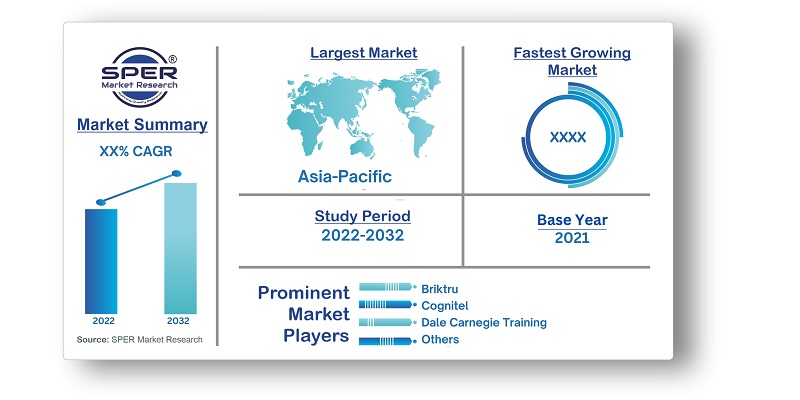
Indonesia Corporate Training Market Growth, Size, Trends, Share, Scope and Future Competition
Indonesia Corporate Training Market Size- By Industry Verticals, By Types of Training Services, By Deployment, By Designation of Employee, By Mode of Learning- Regional Outlook, Competitive Strategies and Segment Forecast to 2032
| Published: Mar-2023 | Report ID: EDUI2316 | Pages: 1 - 104 | Formats*: |
| Category : Education Industry | |||


| Report Metric | Details |
| Market size available for years | 2019-2032 |
| Base year considered | 2021 |
| Forecast period | 2022-2032 |
| Segments covered | By Industry Verticals, By Types of Training Services, By Deployment, By Designation of Employee, and By Mode of Learning. |
| Regions covered | Java, Sumatra, Bali and Nusa Tenggara, Sulawesi, Kalimantan, Papua |
| Companies Covered | Briktru, Cognitel, Dale Carnegie Training, Deloitte Academy, Maverick, PwC Academy |
- Contractual Professional Trainers
- Corporate Training Companies
- Ed-tech Companies
- Freelance Trainers
- Industry Veterans
- Industry/Corporate Coach
- IT Solutions and Support Companies
- Retired Experienced Faculties
- Self-Based Learning Platforms Companies
- Top UG/PG Private Universities
- IT/ITES
- Telecom
- BFSI
- FMCG/Retail
- Automobile
- Manufacturing
- Healthcare
- Technical
- Leadership
- Managerial
- Sales
- Customer Management
- Quality Training
- Technical Training
- Soft Skills
- Brand Training
- On-Site
- Off-Site
- Managerial
- Non-Managerial
- Integrated
- Instructor Led Classroom Only
- Blended Learning
- Virtual Classroom
- Online or Computer Based Methods
- Mobile and Social Learning
- Java
- Sumatra
- Bali and Nusa Tenggara
- Sulawesi
- Kalimantan
- Papua
- Size of Indonesia Corporate Training Market (FY’2019-FY’2032)
- Overview of Indonesia Corporate Training Market
- Segmentation of Indonesia Corporate Training Market By Industry Verticals (IT/ITES, Telecom, BFSI, FMCG/Retail, Automobile, Manufacturing, Healthcare)
- Segmentation of Indonesia Corporate Training Market By Types of Training Services (Technical, Leadership, Managerial, Sales, Customer Management, Quality Training, Technical Training, Soft Skills, Brand Training)
- Segmentation of Indonesia Corporate Training Market By Deployment (On-Site, Off-Site)
- Segmentation of Indonesia Corporate Training Market By Designation of Employee (Managerial, Non-Managerial, Integrated)
- Segmentation of Indonesia Corporate Training Market By Mode of Learning (Instructor Led Classroom Only, Blended Learning, Virtual Classroom, Online or Computer Based Methods, Mobile and Social Learning)
- Statistical Snap of Indonesia Corporate Training Market
- Growth Analysis of Indonesia Corporate Training Market
- Problems and Challenges in Indonesia Corporate Training Market
- Competitive Landscape in the Indonesia Corporate Training Market
- Impact of COVID-19 and Demonetization on Indonesia Corporate Training Market
- Details on Recent Investment in Indonesia Corporate Training Market
- Competitive Analysis of Indonesia Corporate Training Market
- Major Players in the Indonesia Corporate Training Market
- SWOT Analysis of Indonesia Corporate Training Market
- Indonesia Corporate Training Market Future Outlook and Projections (FY’2019-FY’2032)
- Recommendations from Analyst
1.1. Scope of the report1.2. Market segment analysis
2.1 Research data source2.1.1 Secondary data2.1.2 Primary data2.1.3 SPER’s internal database2.1.4 Premium insight from KOL’s2.2 Market size estimation2.2.1 Top-down and Bottom-up approach2.3 Data triangulation
4.1. Driver, Restraint, Opportunity and Challenges analysis4.1.1 Drivers4.1.2 Restraints4.1.3 Opportunities4.1.4 Challenges4.2. COVID-19 Impacts of the Indonesia Corporate Training Market
5.1. SWOT analysis5.1.1 Strengths5.1.2 Weaknesses5.1.3 Opportunities5.1.4 Threats5.2. PESTEL analysis5.2.1 Political landscape5.2.2 Economic landscape5.2.3 Social landscape5.2.4 Technological landscape5.2.5 Environmental landscape5.2.6 Legal landscape5.3. PORTER’S five forces analysis5.3.1 Bargaining power of suppliers5.3.2 Bargaining power of Buyers5.3.3 Threat of Substitute5.3.4 Threat of new entrant5.3.5 Competitive rivalry5.4. Heat map analysis
6.1 Indonesia Corporate Training Manufacturing Base Distribution, Sales Area, Product Type6.2 Mergers & Acquisitions, Partnerships, Product Launch, and Collaboration in Indonesia Corporate Training Market
7.1. IT/ITES7.2. Telecom7.3. BFSI7.4. FMCG/Retail7.5. Automobile7.6. Manufacturing7.7. Healthcare
8.1. Technical8.2. Leadership8.3. Managerial8.4. Sales8.5. Customer Management8.6. Quality Training8.7. Technical Training8.8. Soft Skills8.9. Brand Training
9.1. On-Site9.2. Off-Site
10.1. Managerial10.2. Non-Managerial10.3. Integrated
11.1. Instructor Led Classroom Only11.2. Blended Learning11.3. Virtual Classroom11.4. Online or Computer Based Methods11.5. Mobile and Social Learning
12.1. Indonesia Corporate Training Market Size and Market Share by Region (2019-2025)12.2. Indonesia Corporate Training Market Size and Market Share by Region (2026-2032)12.3. Java12.4. Sumatra12.5. Bali and Nusa Tenggara12.6. Sulawesi12.7. Kalimantan12.8. Papua
13.1. Briktru13.1.1. Company details13.1.2. Financial outlook13.1.3. Product summary13.1.4. Recent developments13.2. Cognitel13.2.1. Company details13.2.2. Financial outlook13.2.3. Product summary13.2.4. Recent developments13.3. Dale Carnegie Training13.3.1. Company details13.3.2. Financial outlook13.3.3. Product summary13.3.4. Recent developments13.4. Deloitte Academy13.4.1. Company details13.4.2. Financial outlook13.4.3. Product summary13.4.4. Recent developments13.5. Maverick13.5.1. Company details13.5.2. Financial outlook13.5.3. Product summary13.5.4. Recent developments13.6. PwC Academy13.6.1. Company details13.6.2. Financial outlook13.6.3. Product summary13.6.4. Recent developments
SPER Market Research’s methodology uses great emphasis on primary research to ensure that the market intelligence insights are up to date, reliable and accurate. Primary interviews are done with players involved in each phase of a supply chain to analyze the market forecasting. The secondary research method is used to help you fully understand how the future markets and the spending patterns look likes.
The report is based on in-depth qualitative and quantitative analysis of the Product Market. The quantitative analysis involves the application of various projection and sampling techniques. The qualitative analysis involves primary interviews, surveys, and vendor briefings. The data gathered as a result of these processes are validated through experts opinion. Our research methodology entails an ideal mixture of primary and secondary initiatives.



Frequently Asked Questions About This Report
PLACE AN ORDER
Year End Discount
Sample Report
Pre-Purchase Inquiry
NEED CUSTOMIZATION?
Request CustomizationCALL OR EMAIL US
100% Secure Payment






Related Reports
Our Global Clients
Our data-driven insights have influenced the strategy of 200+ reputed companies across the globe.




















